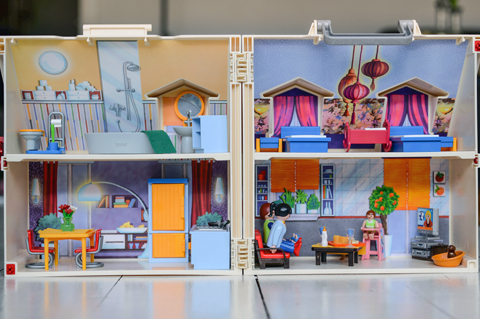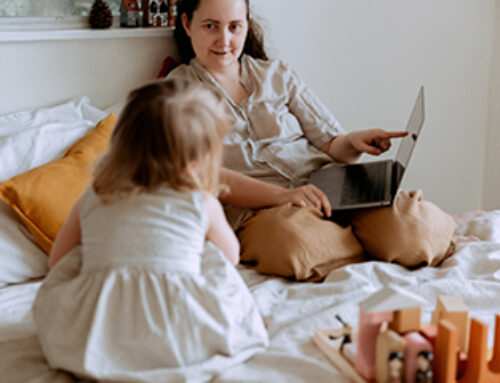What is it? Functional play can be defined as play with toys or objects according to their intended function (e.g., rolling a ball, pushing a car on the floor, pretend to feed a doll).
Why is it important? : Play is a way children learn to make sense of the world. Functional play is a powerful tool for supporting global development. Play develops a child’s problem-solving skills through the discovery of properties of actions and objects (e.g., hard/soft, fast/slow, and how things work together).
Functional play is also important in social interactions. Children interact with each other through play with toys, equipment, and action sequences. Sharing enjoyment in play develops a sense of connectedness with others.

Tips to Support Play:
- Setting up the environment so that the child is able to focus
- Engaging the child in what interests him/her and joining in
- Gradually introducing new toys and sensory experiences because some children need to be exposed to a new toy for a while before initiating a purposeful interaction
- Modeling how to play with the toy and gradually fading support
- Providing rewards or favorite play activities alternated with successful play attempts
- Encouraging the child to imitate his/her peers
- Generalizing play sequences into a social context (e.g., incorporate play with a sibling)
Activities to Try at Home:

1. Cars/ Trains
Many of our kids are highly motivated by cars and trains, but frequently spin the wheels and demonstrate limited functional play and ideation. Below are some simple tips to promote functional play skills in your home environment within each developmental domain.
- Communication: Use simple language narrating play with the child. Model expansion of the child’s verbal output by adding 1-2 words. Examples include labeling “train” or “go”, then pairing the two together “Go train!” paired with the action of moving the train.
- Fine Motor: Building a train track is like a one-step puzzle, promoting problem solving and fine motor control. Using chalk to draw a train track or road can be a fun way to incorporate drawing into play and can also promote visual attention for your child to be able to follow the road/ track.
- Gross Motor: Positioning while engaged in play on the floor is a great way to incorporate strengthening into functional play. Encourage your child to sit up without leaning or have them lay on their belly propped on their elbows. Be sure to encourage your child to keep their head up to promote full-body strengthening! Incorporating a game of “chase” with cars while in a crawling position can promote reciprocal movement patterns, shoulder girdle and postural stability, and social play. You can also have your child engage in a bridge (holding self up on hands and feet) and roll the car or train under.
- Social-Emotional: Use of highly preferred toys to promote joint attention and practice turn-taking can be highly effective and is a great place to begin for social play. Rolling the car back and forth between you and your child is a way to engage in turn-taking while promoting joint attention, a foundational skill of learning. You can also promote skills of turn-taking by offering to trade another highly preferred toy and engage in parallel play with your child, promoting ideation through modeling. Help your child begin to use these skills with siblings or friends once they begin to master these games with you, working towards the generalization of skills, sharing, and social interactions.
- Cognition: You can help your child work on following one-step commands of “Stop!” and “Go!” with toys, eventually expanding to “Red Light, Green Light.” Modeling prepositions to describe the location of the toy (under the table, on top of the book, over the track) while paired with the action can promote understanding of these concepts.
- Expanding beyond functional play:
- Set up themes and incorporate other toys (the train has to pick up food and deliver for a picnic, the cars are visiting family members, the train has to bring animals to the vet)
- Develop problem-solving skills (the car broke a wheel, how can we fix it?)

2. Books
Books are a great item to promote functional play. Depending on the language ability of the child, reading the words isn’t required!
- Communication: Commenting on the pictures with simple language and high effect can promote interest and engagement. Examples: “Look!” paired with a gesture of pointing, as well as labeling pictures in the book. For kids with a higher-level language, work on inferencing or predicting what will happen next in the story and ask wh– questions to promote comprehension of the story.
- Fine Motor: Encourage your child to hold the book, turn the pages, and point towards pictures in the book. Upgrade the task by using books with more delicate pages.
- Gross Motor: Focus on positioning: upright posture (without leaning), half kneel, or lying on stomach propped on elbows while looking at the book, working on postural control while engaged in a stationary activity.
- Social-Emotional: Exploring emotions and how characters are feeling. You can begin by introducing emotions and modeling language “He’s sad. Show me a sad face.” As your child begins to understand these concepts, additional discussion on how characters are feeling can expand the discussion.
- Cognition: Orienting the book/ pictures (right side up, visually scanning from left to right), promoting visual attention by identifying and labeling objects in the book, introducing the concept of a beginning, middle and end of the book and recalling what happened in the story after you’ve finished reading it.
- Expanding beyond functional play:
- Answer questions about the story (what happened, what do you think will happen).
- Relate personal events to the story or act out the story.
- Take perspectives of the character (how would you feel, what would you do).

3. Legos or Blocks
Legos are a great toy to use with kids with a variety of skill sets.
- Communication: Narrate what your child is building. You can label the colors of the legos, and pair with simple action phrases (on top, fall down). You can also work on receptive language, such as following directions with concepts of colors and sizes.
- Fine Motor: Start small, targeting visual attention at midline and bilateral coordination by modeling play. You begin by placing 2 legos together and pulling them apart paired with simple, one-step commands (apart, together). Upgrade by having a child stack and make a tower, up to building a house, and incorporating pretend play.
- Gross Motor: Place lego pieces on a waist-high surface, prompting your child to maintain a tall kneel while engaging in play. If your child is highly motivated by legos, you can place the bin containing legos 10-15 feet from the work surface, having your child engage in animal walks, rolling, jumping, or other movement activities to retrieve pieces. You can go all the way up on their tiptoes to create a tall tower and kick it down!
- Social-Emotional: Incorporate turn taking and cooperative play, where you work with your child to build a tower. You can also target your child’s frustration tolerance and coping strategies by accidentally knocking down the tower prematurely, narrating that it’s okay to make mistakes and modeling how to solve the problem.
- Cognition: Legos and blocks are a great way to work on cause and effect play. This can be as simple as banging the blocks together to make a sound and can progress to building a tower and knocking it down. Legos can target sustained attention, providing foundational skills for engaging in seated academic tasks. As your child’s skills grow, have them try to follow a model that you provide. It could be a two-step color pattern or something more complex like a pyramid!
- Expanding beyond functional play:
- Incorporating other toys (make houses, zoos, cities, incorporate your own storyline).
- Higher-level “lego kits.”
- Take a photo of a structure and have your child recreate it.

4. Baby Doll/ Doll House
As your child’s play skills begin to develop, you can start to incorporate relational and symbolic play. Baby dolls and dollhouses are a great way for a child to explore their roles and expand on their play in a variety of ways.
- Communication: Follow your child’s lead, and work to expand their output of communication with modeling of action words or descriptive words. Incorporating sounds paired with play ideas, such as a snoring sound while lying the baby down to simulate sleep, can help promote engagement and participation in play. Modeling simple, one to two-word labels can help promote language development during play.
- Fine Motor: Incorporate routines that the child engages in themselves such as feeding, toileting, or dressing to practice familiar motor plans. Use of the baby doll to model these self-care routines can help promote fine motor skills as well as increase your child’s confidence in their ability to complete these routines for themselves.
- Gross Motor: Continue to monitor your child’s position while engaged in play.
- Social-Emotional: Dolls can be used to explore emotions, helping to make sense of simple emotions (sadness, happiness) as well as increasingly complex emotions (frustration, jealousy). It can also help a child to understand that others have feelings that may differ from their own, provide an opportunity for a child to learn to care for another, and foundational skills for nurturing and empathy.
- Cognition: Ideation and expansion of play ideas and sequencing of play ideas can promote cognitive development. Providing examples of simple play ideas that reflect daily life (sleeping, waking up, eating, toileting), can help your child begin to draw connections between dolls and themselves, promoting their ability to understand their own roles, routines, and environment.
- Expanding beyond functional play:
- More complex play schemes.
Some of our favorite toys:
- LEGO Duplo Creative Play: all in one box of fun
- LEGO Duplo Big Construction Site
- LEGO Duplo Jurassic World
- Melissa and Doug Wooden Block Set
- Magnetic Tiles
- Melissa and Doug Wooden Train Set
- Construction Vehicle Toys with Play Mat
- Fisher-Price Little People Houses
- Melissa and Doug Fold and Go House
- B. toys by Battat – B. Pet Vet Toy

Blue Bird Day fosters socialization, sensory regulation, and pre-academic learning in children ages 2-7 years in therapeutic rotations that simulate preschool and kindergarten settings. Our compassionate therapists practice a relationship-based and family-centered approach, provide parent training, and collaborate on goals and individualized intensive treatment plans for your child.
We believe in a collaborative and multi-disciplinary team approach to therapy. A team of occupational therapists, speech-language pathologists, dietitians, developmental therapists, behavioral therapists, physical therapists, and therapeutic assistants are created for each child to ensure child and family are fully supported and the best possible results are achieved.
Options for individualized, group and virtual therapy sessions are available as well.
Want to learn more or you have a specific question? Feel free to connect with us here!



